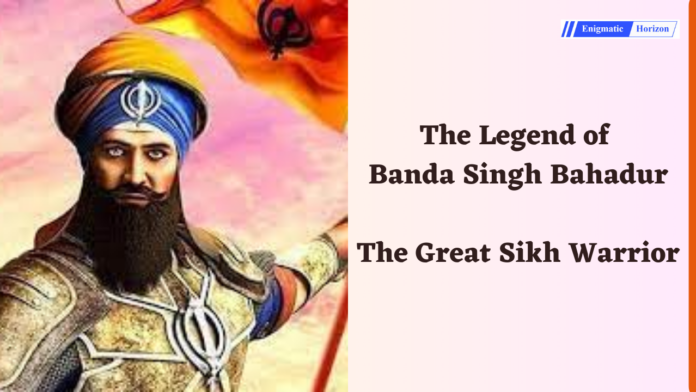Priyal Dholakia – Enigmatic Horizon Staff (Assistant Editor)
“Jo Bole So Nihal, Sat Sri Akal!”
This war cry lives on in the hearts of Sikhs as the core essence of Sikhism. There are many unsung Sikh fighters who have given their lives to uphold this eternal ideal. One such legendary figure was Banda Singh Bahadur. And here is his story:
Banda Singh Bahadur was a valiant patriot who lived his life on the edge of the sword. He challenged the stronghold of the Mughals and rescued people from Mughal tyranny. He laid the foundation of the First Sikh Kingdom (the Khalsa Raj) by vanquishing the Mughals. The legend of Banda Singh Bahadur is one of undying sacrifice and bravery. Through his heroic deeds, he embodied the very spirit of valor and triumph. Let us revive the long-lost saga of this forgotten warrior.
A glimpse into the life of Banda Singh Bahadur
Banda Singh Bahadur was more than a brilliant warrior and commander. He was a revolutionary spiritual leader and saint as well. Banda Singh was a fervent disciple of Guru Gobind Singh and an important Sikh icon. Under Guru Gobind Singh’s tutelage, he converted to Sikhim and became a warrior. For about six years, he was able to conquer the Mughals and founded the first Sikh Raj. The Mughals outnumbered his army in military, manpower, and even war resources. Despite this, he stood up to the Mughals’ tyranny and was able to sack their provincial capitals.
How Banda Singh threatened Mughal strongholds and saved people from Mughal tyranny
In 1708, Banda Singh Bahadur set out towards Khanda, Sonepat, with his tiny but brave Sikh army. Khanda village was an important Mughal outpost. and the Mughal forces used to oppress the locals there. Under Banda Singh’s leadership, the Sikhs were able to overthrow the Mughal Faujdar there. After doing that, they disbursed the treasury’s wealth among the poor and needy of the village. Later, in 1709, these gallant Sikh soldiers marched towards Samana. Samana was an important city for the Mughals. The Sikhs conquered that too and got rid of all the tyrannic oppressors there. Then, in 1709, Banda Singh’s army marched towards Sadhaura and captured that as well. With Banda Singh’s valor, Mughal supremacy in Delhi was at stake for the first time in about 150 years.
The Battle of Chappar Chiri and the Foundation of Sikh Rule in Punjab
In 1710, Banda Singh chose to attack Wazir Khan, the Mughal Governor, in Sirhind (Fatehgarh). The Sikhs were vastly outnumbered compared to the Mughal army. They even lacked basic war resources like war elephants. while the Mughals were armed with musketeers, artillery support, war elephants, and firearms. Despite the odds, Banda Singh’s army was able to vanquish the dictator Wazir Khan and his troops. There is a 100-meter-tall minar called Fateh Burj that still stands tall in Chappar Chiri. It is a standing testimony to commemorate the Sikhs’ triumph against the Mughals.
Thus, after capturing Sirhind, the Sikhs established Sikh rule over Punjab. They set their capital at Lohgarh under the leadership of Banda Bahadur in 1710. The Sikhs were now in command of land stretching from the Sutlej to the Yamuna Doab. They were successful in breaking the backbone of the Mughals’ alternate capitals. These included prominent bases like Agra, Delhi, and Lahore.
Battle of Rahon
Banda Singh Bahadur had captured Punjab to the east of Lahore by this point. He then beat the Mughals at Rahon while on his way to Jalandhar. All efforts of Emperor Bahadur Shah’s to defeat Banda Singh proved futile. Soon after winning these battles, Banda Singh Bahadur abolished the Zamindari system. He granted property rights to the farmers and ensured their well-being. He also established a mint in the names of Guru Nanak and Guru Gobind Singh to produce coins and stamps. The Sikhs then beat the Mughals in the battle of Jalalabad. They took control of the territory between Lahore and Delhi. Banda Singh went to Jammu and planned to launch another attack against the Mughals. From Jammu to the Sutlej, he established his new empire.
The barbaric acts of Mughals against Banda Singh
In 1715, the Mughals arrested Banda Singh by force. They mercilessly killed his fellow Sikh soldiers one by one. The Mughals then imprisoned Banda Singh in an iron cage and tortured him to death. The Mughal soldiers offered Banda Singh a deal in which he would be spared his life if he accepted Islam. But the mighty warrior Banda Singh rejected. Despite severe torture, the brave Banda Singh Bahadur stood firm and died as a martyr at the age of 45.
Banda Singh’s glorious legacy lives on as a golden chapter in the history of Sikhism. He immortalized himself in the pursuit of greater good for all. It is important that his legacy is passed to our youth and future generations to come. That is the least we can do to honor the relentless sacrifice of this legendary warrior.
